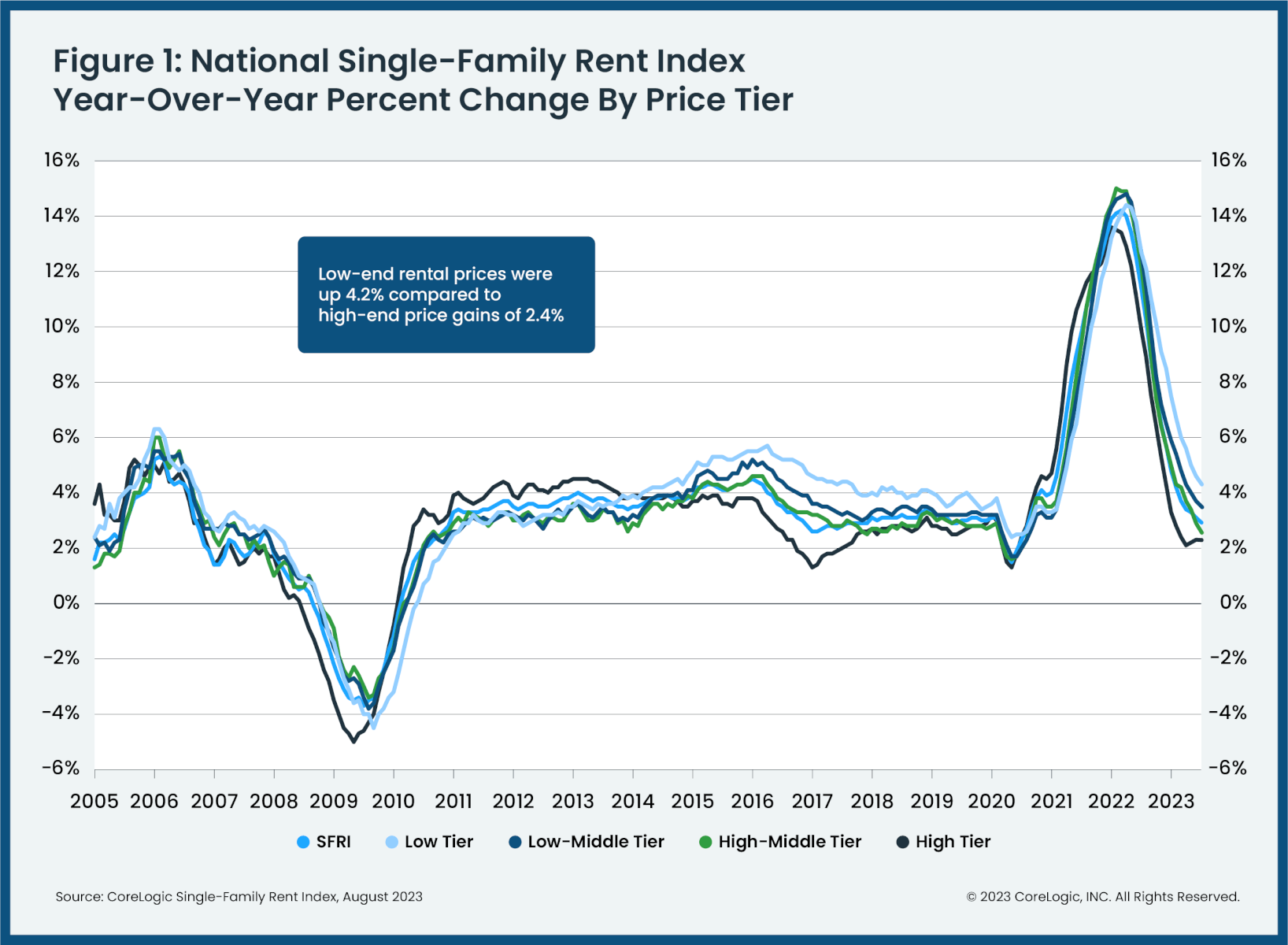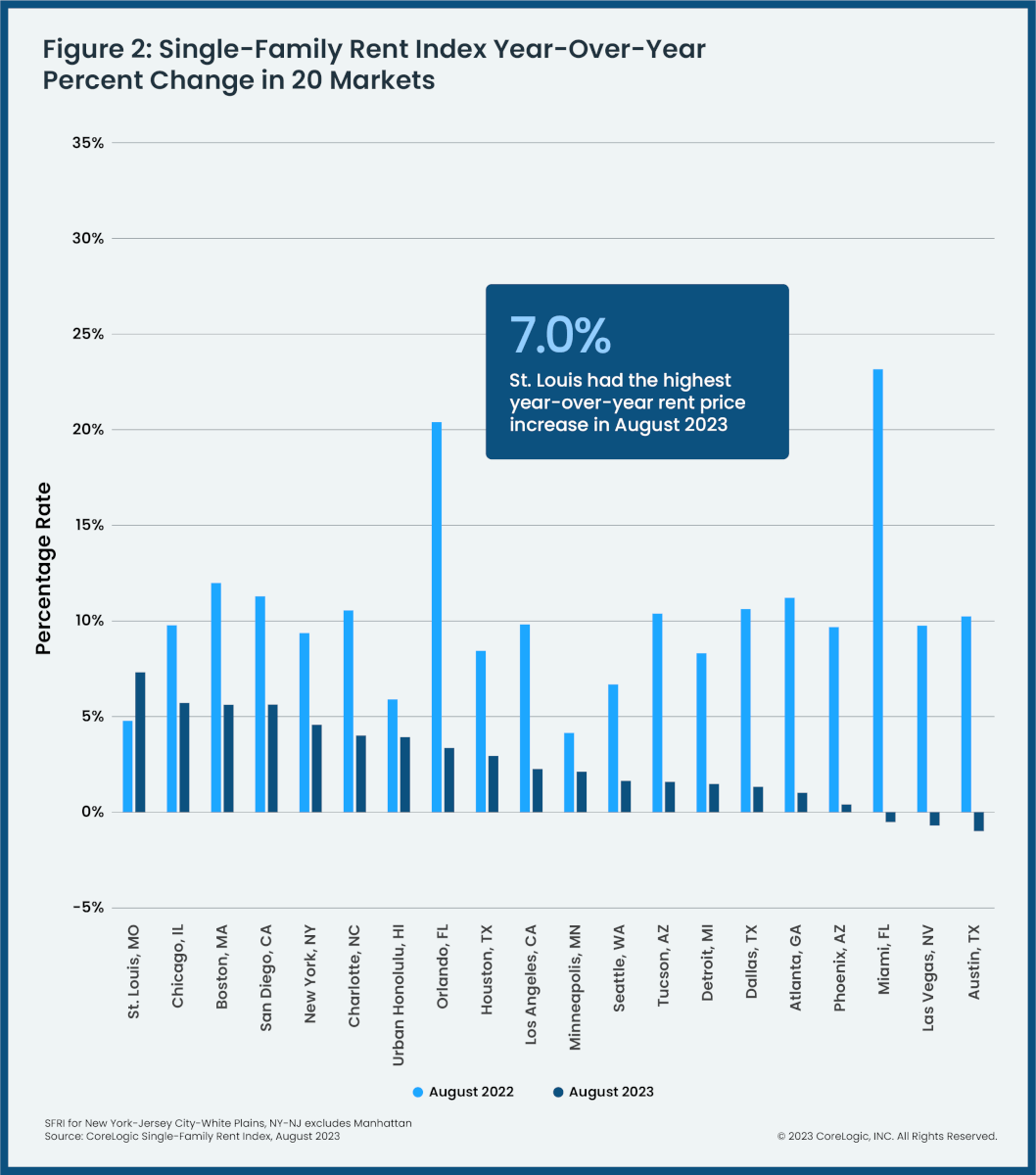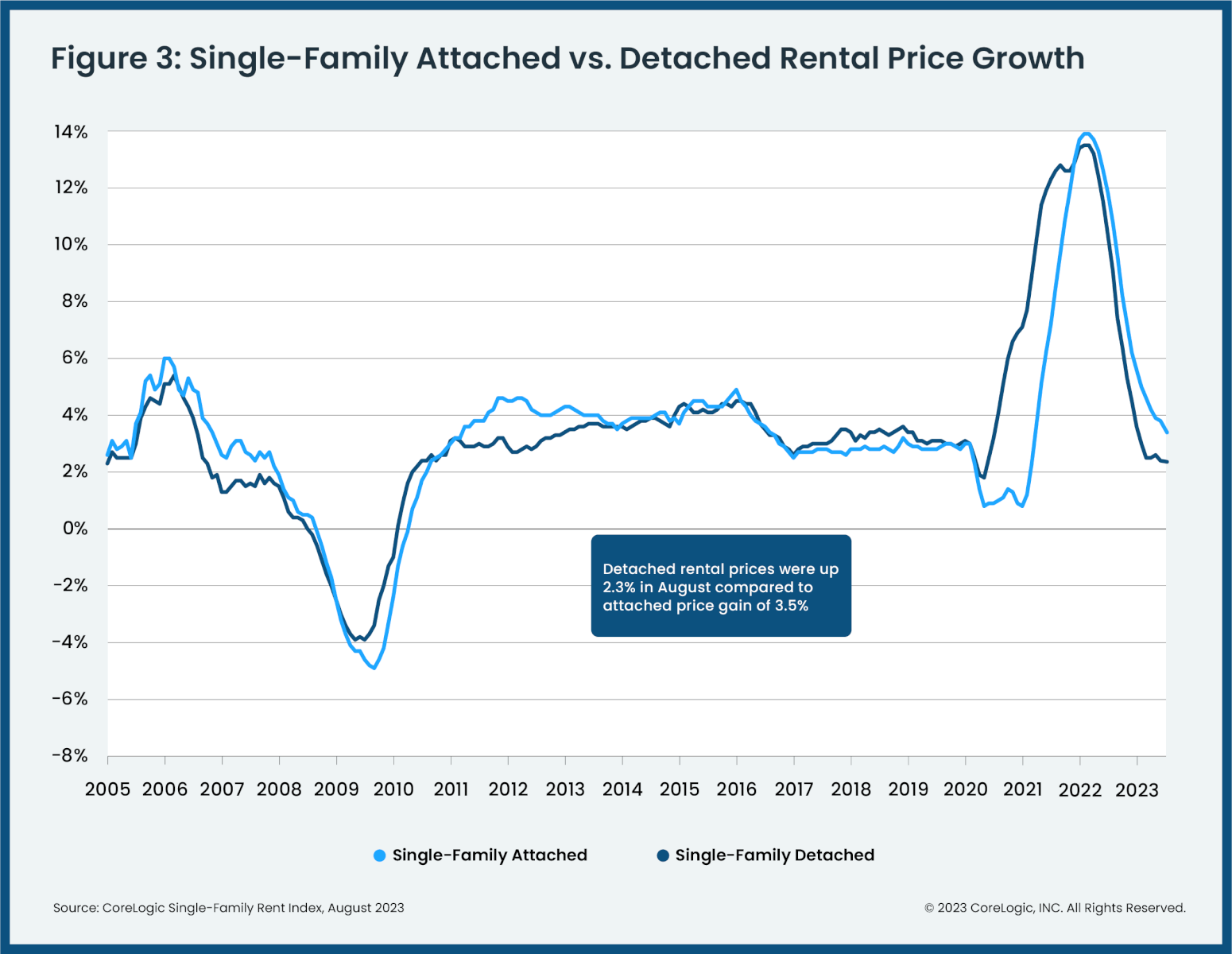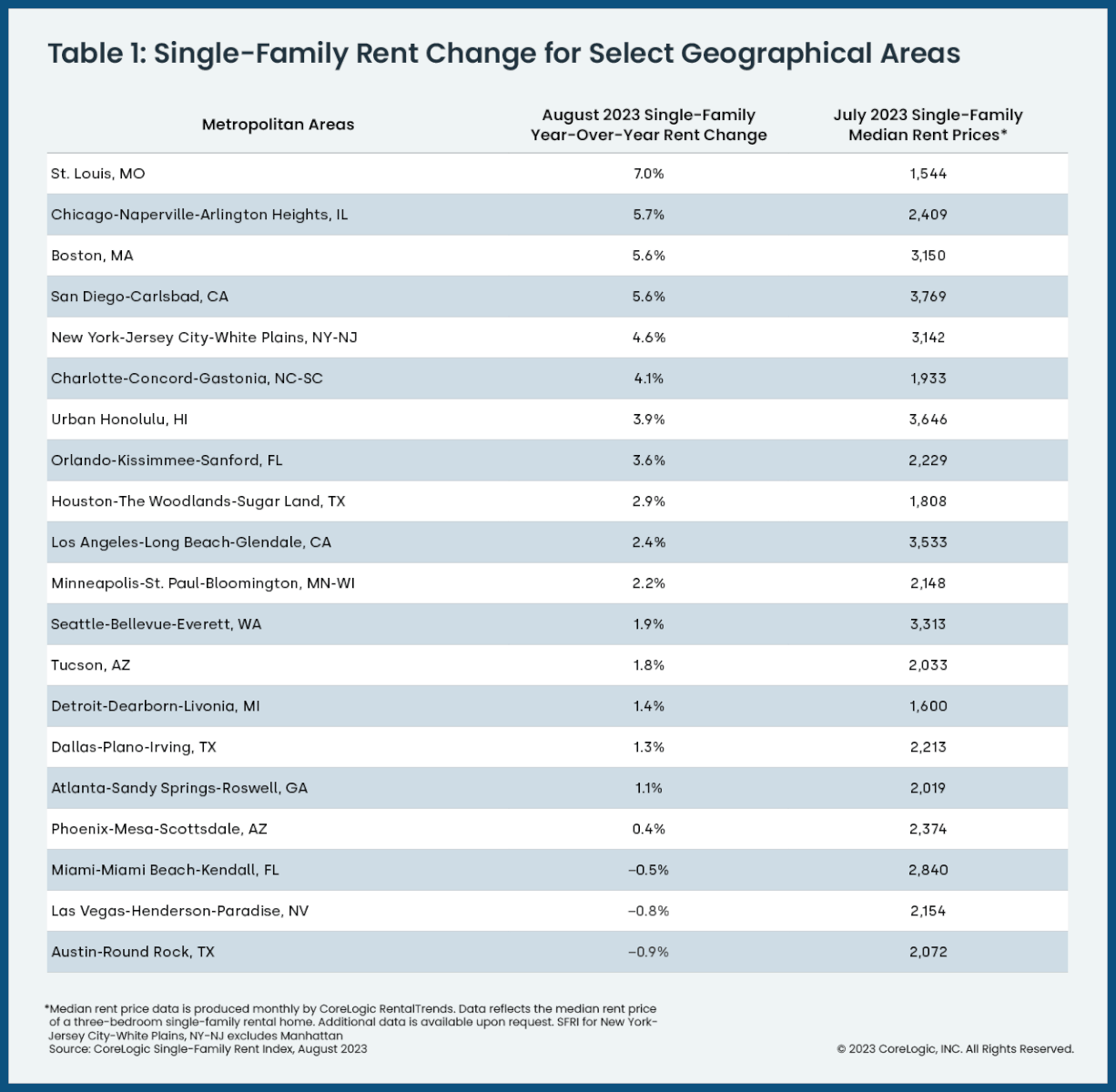- Annual U.S. single-family rent growth slowed to 2.9% in August, the 16th consecutive month of declines.
- Single-family rents have increased by 30% nationwide since February 2020.
- August’s year-over-year attached rental costs gains (3.5%) continued to outpace those of detached properties (2.3%).
- As in the previous month, St. Louis and Chicago saw the nation’s highest year-over rent growth in August, while some major Sun Belt metros continued to post small losses.
IRVINE, Calif., October 17, 2023—CoreLogic®, a leading global property information, analytics and data-enabled solutions provider, today released its latest Single-Family Rent Index (SFRI), which analyzes single-family rent price changes nationally and across major metropolitan areas.
Although annual U.S. single-family rent growth eased again in August, renters are still feeling the pinch. According to a recent CoreLogic analysis, the average American renter household spends about 40% of its income on housing costs, with lower-income tenants bearing much of the brunt of inflation. The SFRI’s low tier saw the largest year-over-year rental cost gain in August (up by 4.2%), while the high tier registered a 2.4% annual increase.
“While annual single-family rent growth has returned to a moderate pace, more than three years of substantial increases will have a lasting impact on tenants’ budgets,” said Molly Boesel, principal economist for CoreLogic. “Single-family rents grew by 30% since February 2020, and small drops in some areas barely put a dent in the overall, cumulative increase. For example, even though rents in the Miami metro area have declined by 0.5% since August 2022, they are still 51% higher than they were before the pandemic began.”
To gain a detailed view of single-family rental prices across different market segments, CoreLogic examines four tiers of rental prices and two property-type tiers. National single-family rent growth across those tiers, and the year-over-year changes, were as follows:
- Lower-priced (75% or less than the regional median): up 4.2%, down from 12.6% in August 2022
- Lower-middle priced (75% to 100% of the regional median): up 3.3%, down from 12.7% in August 2022
- Higher-middle priced (100% to 125% of the regional median): up 2.6%, down from 12.1% inAugust 2022
- Higher-priced (125% or more than the regional median): up 2.4%, down from 9.8% in August 2022
- Attached versus detached:Attached single-family rental prices grew by 3.5% year over year in August, compared with the 2.3% increase for detached rentals
Of the 20 metros shown in Table 1, St. Louis posted the highest year-over-year increase in single-family rents in August 2023, at 7%. Chicago registered the second-highest annual gain at 5.7%, followed by Boston and San Diego (both 5.6%). Austin, Texas (-0.9%), Las Vegas (-0.8%) and Miami (-0.5%) again saw slight year-over-year rental cost decreases.
The next CoreLogic Single-Family Rent Index will be released on November 21, 2023, featuring data for September 2023. For ongoing housing trends and data, visit the CoreLogic Intelligence Blog: www.corelogic.com/intelligence.




Methodology
The single-family rental market accounts for half of the rental housing stock, yet unlike the multifamily market, which has many different sources of rent data, there are minimal quality adjusted single-family rent transaction data. The CoreLogic Single-Family Rent Index (SFRI) serves to fill that void by applying a repeat pairing methodology to single-family rental listing data in the Multiple Listing Service. CoreLogic constructed the SFRI for close to 100 metro areas — including 43 metros with four value tiers — and a national composite index . The indices are fully revised with each release to signal turning points sooner.
The CoreLogic Single-Family Rent Index analyzes data across four price tiers: Lower-priced, which represent rentals with prices 75% or below the regional median; lower-middle, 75% to 100% of the regional median; higher-middle, 100%-125% of the regional median; and higher-priced, 125% or more above the regional median.
Median rent price data is produced monthly by CoreLogic RentalTrends. RentalTrends is built on a database of more than 11 million rental properties (over 75% of all U.S. individual owned rental properties) and covers all 50 states and 17,500 ZIP codes.
Source: CoreLogic
The data provided is for use only by the primary recipient or the primary recipient’s publication or broadcast. This data may not be re-sold, republished or licensed to any other source, including publications and sources owned by the primary recipient’s parent company without prior written permission from CoreLogic. Any CoreLogic data used for publication or broadcast, in whole or in part, must be sourced as coming from CoreLogic, a data and analytics company. For use with broadcast or web content, the citation must directly accompany first reference of the data. If the data is illustrated with maps, charts, graphs or other visual elements, the CoreLogic logo must be included on screen or website. For questions, analysis or interpretation of the data contact Robin Wachner at newsmedia@corelogic.com. For sales inquiries, please visit https://www.corelogic.com/support/sales-contact/. Data provided may not be modified without the prior written permission of CoreLogic. Do not use the data in any unlawful manner. This data is compiled from public records, contributory databases and proprietary analytics, and its accuracy is dependent upon these sources.
About CoreLogic
CoreLogic is a leading provider of property insights and innovative solutions, working to transform the property industry by putting people first. Using its network, scale, connectivity and technology, CoreLogic delivers faster, smarter, more human-centered experiences that build better relationships, strengthen businesses and ultimately create a more resilient society. For more information, please visit www.corelogic.com.
CORELOGIC and the CoreLogic logo are trademarks of CoreLogic, Inc. and/or its subsidiaries.
Media Contact
Robin Wachner
CoreLogic
newsmedia@corelogic.com


